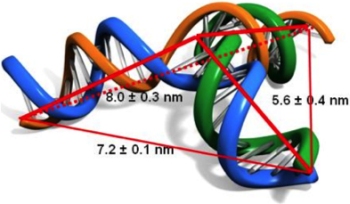May 18 2013
Cornell researchers Jenny Sabin, assistant professor of architecture, and Dan Luo, professor of biological and environmental engineering, are among the lead investigators on a new research project to produce “buildable, bendable and biological materials” for a wide range of applications.
 A 3-D model of a Y-shaped DNA structure, used as a building block for DNA-based gels. Cornell researchers will work to develop innovative materials, including DNA-polymer hybrids, from the nano to the architectural scale. Provided/Dan Luo laboratory
A 3-D model of a Y-shaped DNA structure, used as a building block for DNA-based gels. Cornell researchers will work to develop innovative materials, including DNA-polymer hybrids, from the nano to the architectural scale. Provided/Dan Luo laboratory
Sabin and Luo will share in a $2 million, four-year National Science Foundation grant with University of Pennsylvania researchers Randall Kamien, physics, and Shu Yang, materials science.
The project is intended to bring new ideas, motifs, portability and design to the formation of intricate chemical, biological and architectural materials.
Based on Kirigami (from the Japanese word kiru, “to cut”), the project “offers a previously unattainable level of design, dynamics and deployability” to self-folding and unfolding materials from the molecular scale to the architectural level, according to the researchers.
The research will include cutting and joining nano-sized DNA-polymer hybrids, 3-D printing and geometric models on the macroscopic scale.
Researchers also will develop new tools to visualize the folding and optimization of 2- and 3-D structures, and generate new hybrid building blocks from the tiny to the large.
The project is intended to illuminate new principles of architecture, materials synthesis and biological structures, and advance several technologies – including meta-materials, sensors, stealth aircraft and adaptive and sustainable buildings. A complementary goal is to generate public interest through an enhanced impact on science, art and engineering.
“Like the opening and closing of flowers, satellites and even greeting cards, our research will offer a rich and diverse set of intricate surprises, problems and challenges for students at all levels, and broaden their interest and awareness of emerging science and engineering,” according to the project proposal, “Cutting and Pasting: Kirigami in Architecture, Technology and Science” (KATS).
The Emerging Frontiers in Research Innovation grant from the NSF is in the research category of Origami Design for Integration of Self-assembling Systems for Engineering Innovation.